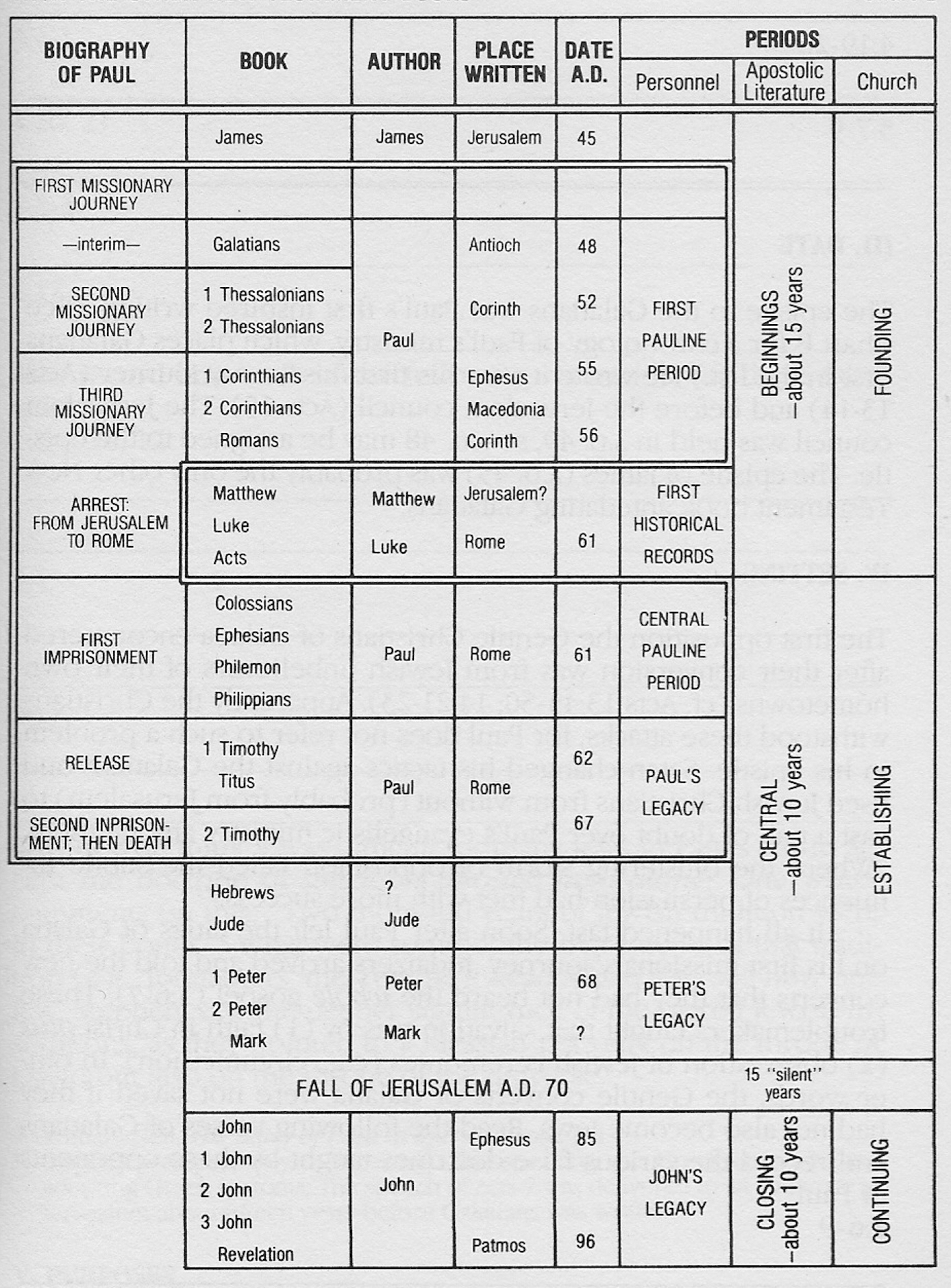INTRODUCTION TO GALATIANS
Some part from Irvine L. Jensen
The Moody Bible Institution of Chicago
copyright © 1973
Used by permission.
QUESTIONS TO STUDY ONE
OUTLINE
MAP OF PAUL'S FIRST AND SECOND MISSIONARY TRIPS
MAP OF PAUL'S THIRD MISSIONARY TRIP

Before analyzing the text of any book of the Bible, it is well to learn the historical background. Also, it is best to make a mountain top view of its general contents.
1) viewing the background
2) surveying the whole book
3) analyzing the parts.
- TIMELINE
- Paul was born and grew up in Tarsus (4 A.D.) Jesus was born around the same time. *
- Paul meet Christ on the road to Damascus and thus became a Christian (33 to 35 A.D. Acts 9:1-18)), five years after Pentecost.
- Paul and Barnabas first missionary journey (from 46 to 48 A.D., Acts 13-14)
- The Jerusalem counsel held. (either 49 or 50 A.D., Acts 15)
- Some believe that Paul wrote Galatians while at Antioch between the first and second mission trips. (48 A.D.)
- Paul and Silas left Antioch on Paul's second missionary trip. He went through Tarsus on the way to the churches in Galatia where young Timothy joins them. (Early 50 A.D., Acts 15:36-16:10)
- The same year crossing the Aegean Sea arriving at Philippi. (Acts 16:11-40)
- They flee Philippi after considerable time there and went to Thessalonica were they spend considerable time. (Acts 17:1-9)
- Paul and Silas flee from Thessalonica to Berea. Since Timothy is not mentioned, it is possible that he stayed in Thessalonica or Philippi and then rejoined Paul in Silas in Berea.
- Paul fled to Athens from Berean persecution, leaving Silas and Timothy in Berea. (14) Paul asked Silas and Timothy to join him in Athens. (Acts 15, and 1 Thess. 3:1-2)
- Timothy rejoined Paul at Athens and was sent back to Thessalonica. (1 Thess. 3:1-5) Since Silas is not mentioned, it has been conjectured that he went back to Philippi when Timothy went to Thessalonica.
- Paul moved on the Corinth. (Acts 18:1) Silas and Timothy came to Paul in Corinth. (Acts 18:5, 1 Thess. 3:6)
- Paul wrote 1 Thessalonians and sent it to the church. About six months later in late 51 or early 52 A.D. Paul wrote 2 Thessalonians.
- Most believe that Paul wrote Galatians while in Corinth or perhaps when he arrived back at Antioch at the end of his second mission trip (late 52 A.D.)
- Paul returned to Ephesus during the early part of his third missionary journey. (53 A.D.) He stayed there for two years. (Acts 19:1-20)
- Paul left Ephesus to visit the congregations he had went to on his second missionary trip. (Acts 19:21-20:1)
- Paul stopped at Corinth on the looped journey where he penned the letter to the believers in Rome. He made a short stop in Ephesus and then went to Jerusalem. (56 A.D., Acts 20:2-38)
- Paul ended the third missionary trip in Jerusalem. He presented a gift that was collected for the poor and needy in Jerusalem. (57 A.D., Acts 20:39-21:16)
- Paul was arrested in Jerusalem when the Jews tried to kill him. (57 A.D., Acts 21:17-40)
- AUTHOR
The writer is identified in the text as "Paul, an apostle" (1:1; cf. 6:11) and has not be disputed apart from a few 19th century scholars. Some interesting things are to be said about his name. Paul, meaning "little," was his Roman name. His Hebrew name was Saul ("asked of God"). Possibly he had both names from childhood. In his epistles the apostle always refers to himself as Paul. Consult a concordance for all the references to the two names in the New Testament. Read Acts 13:9, which is the turning point in Acts for the changeover of designation from Saul to Paul.
Read Galatians 1:2 and observe that other Christians joined with Paul in greeting the Galatian churches: "all the brethren which are with me."
- DESTINATION (TO WHOM WRITTEN)
- Main Views
- The text identifies the original readers as "the churches of Galatia" (1:2; cf. 3:1). The other places in the New Testament where the reference to "Galatia" appears are: 1 Corinthians 16:1; and 2 Timothy 4:10; and 1 Peter 1:1; Acts 16:6; 18:23.
- It is interesting to observe that this is the only Pauline epistle addressed as such to a group of churches. Some of Paul's epistles (Ephesians) were intended to be circulated among churches, even though one church was designated as the original recipient.
- Galatian Cities
- Antioch (in the south; not the city with the same name that was Paul's home base)
- Lystra (in the south)
- Iconium (in the south)
- Derbe (in the south)
- Pessinus (in the north)
- Ancyra (in the north)
- Tavium (in the north)
- City Locations
- Where were these "churches of Galatia" located? Two different views are held on this:
- the North Galatian View -churches founded on Paul's second missionary journey when he passed through the northern districts of Asia Minor;
- the South Galatian View -churches founded on Paul's first missionary journey and passed through on his second missionary journey.
- The latter view is the one held by most expositors today.
- The position is that the "churches of Galatia" were located in the southern cities evangelized by Paul on his first missionary journey.
- Acts 13:1-14:28 is Luke's reporting of Paul's first missionary journey. Study especially the ministries and events at the four Galatian cities mentioned above. These are the cities where Paul won converts and founded the churches to whom he wrote Galatians. Note: Paul's return trip on the first missionary journey (Acts 14:21-27) might be called a second visit to the people. Observe that as of Acts 14:23, churches in the area are already being established.
- It is generally believed that most of the Galatian believers were of Gentile background. This supported by the following verses in Galatians?
- 4:8
- 5:2
- 6:12
- 2:5 (in its context)
- See maps links above for the location of churches in Galatia who would have read Paul's letter sooner or later. Compare these with the locations of the churches to whom John sent Revelation (Rev 1:11). Read Acts 19:8-10; 20:31 for references to Paul's first and second missionary trips.
DATE AND PLACE WRITTEN
- Two Possible Dates:
- The epistle to the Galatians was Paul's first inspired writing. Some believe Paul wrote it after his first missionary trip (Acts 13-14) and before the Jerusalem council (Acts 15). If so, then the epistle of James (A.D. 45) was probably the only other New Testament book antedating Galatians.
- The epistle to the Galatians was Paul's third inspired writing. Most believe Paul wrote it at the end of his second missionary trip. Some holding this view said it was written in Corinth and other when he arrived back at Antioch.
- See chart for a chronology of Paul's ministry and the time line next to it.
OCCASION AND PURPOSE OF THE EPISTLE
The first opposition the Gentile Christians of Galatia encountered after their conversion was from Jewish unbelievers of their own hometown (cf. Acts 13:45-50; 14:21-23). Apparently the Christians withstood these attacks, for Paul does not refer to such a problem in his epistle. Satan changed his tactics against the Galatians and used Jewish Christians from without (probably from Jerusalem) to cast a pall of doubt over Paul's evangelistic ministry among them. "Where the blustering storm of opposition failed the subtle influences of persuasion had met with more success." **
It all happened fast. Soon after Paul left the cities of Galatia, Judaizers arrived and told the new converts that they had not heard the whole gospel (1:6-7). These troublemakers taught that salvation was by faith in Christ plus observation of Jewish ceremonies (e.g., circumcision, Feasts. etc.). In other words, the Gentile converts of Galatia were not saved if they had not also become Jews. Read Galatians 1:6-9 and record the various false doctrines taught by these opponents of Paul.
Why do you think it was difficult for many Jews in Paul's day to accept the doctrine of salvation through faith alone? One writer comments on this, "Two thousand years of Jewish tradition were in their bones." What were some of the ingredients of that tradition (e.g., forefathers, the Temple)? Read Acts 6-7 to see how one Jew, Stephen, saw the deeper significance of the sacred Jewish institutions, as they pointed to a Messiah not only on the throne of David but also on the throne of the universe. ***
PURPOSES
Some of the main purposes of Paul in writing this epistle were:
- To expose the false teachings of the Judaizers who were undermining the faith of the new converts
- To defend Paul's apostleship, which was being challenged by these Judaizers
- To emphasize that salvation is through faith alone, not faith plus law
- To exhort the Galatian Christians to live in the liberty brought by Christ (5:1), bringing forth fruit of the Spirit (5:22-23)
CHARACTERISTICS (Distinguishing Marks)
- Many contrasts.
- Strong statements. Paul was justifiably incensed over the destructive work of the troublemakers. Twice in the opening chapter he writes, "Let him be accursed." "The Epistle to the Galatians is spiritual dynamite, and it is therefore almost impossible to handle it without explosions."***** The writer of this epistle has been described as "a man with a brilliant mind, a trenchant controversialist, a fearless fighter... a man whose life was 'hidden with Christ in God.'"******
- Clear distinction between faith and works as the condition for salvation. The book has been used of God to bring spiritual awakening to such men as Martin Luther and John Wesley. Luther said this of Galatians: "It is my epistle; I have betrothed myself to it: it is my wife."
- Classic treatment of Christian liberty. This is why the epistle has been called "The Magna Charta of spiritual emancipation."
- No congratulations or words of praise. It was not that there was nothing commendable about the Galatians' spiritual lives. But the epistle was written under the strain of urgency, over a situation of emergency. Paul would have later contacts with the churches when he could inspire them through commendation.
RELATION TO OTHER NEW TESTAMENT BOOKS
- Galatians and James.
It is interesting to observe that if these are the first two New Testament books to be written, then they concerned themselves with the subject of works. Each book stressed a different, though not contradictory, aspect of that common subject. James was addressed to the error of antinomianism (from anti, "against," and nomos, "law"), which said that since a person is saved by grace through faith, works thereafter are not important. (Read James 2:14-26.) Galatians was addressed to the error of what might be called Galatianism, which said that one is saved through faith and perfected by the keeping of the law, thus salvation is by faith plus works.
Stated another way,
- Galatians teaches liberation by the gospel
- James teaches compulsion of the gospel.
A study of Galatians made in conjunction with a study of James brings out the stable, balanced New Testament teaching on the place of works in the doctrine of salvation.
- Galatians and Romans
The subject of works is also prominent in Romans, the epistle that exposes the error of legalism, which says that a person is saved by works. The subject of justification by faith appears often in both Romans and Galatians. (Read Gal. 2:16-17; 3:11,24; 5:4; Rom. 3:20, 24, 28; 5:1, 9.) The large subject of salvation is treated more fully in Romans. It has been said that Galatians is the "rough block" of what appears in more finished form in Romans, written eight years later.
- Galatians and 2 Corinthians
Much of 2 Corinthians is devoted to a defense of Paul's apostleship (e.g., 2 Cor. 10-13), because Paul's opponents were stirring up the Corinthian believers by challenging his credentials as an apostle. In the first two chapters of Galatians, Paul defends his apostleship, which was challenged by the same kind of troublemakers. If you have already studied 2 Corinthians you will want to recall its apologia passages when you study Galatians 1-2.
As you conclude your overview of Galatians, ponder over the key verses 2:16 and 3:14.
* See James Stalker, The Life of St. Paul, pp. 17·18. Because of this coincidence, one can quickly estimate Paul's age at any given A.D. date.
** C.F. Hogg and W.E. Vine, The Epistle to the Galatians, p. 7.
*** William Neil, The Letter of Paul to the Galatians, p.4.
**** Stephen was probably a Hellenistic Jew speaking the Greek language and adopting Greek customs. The speech of Acts 7 was delivered to an audience in Jerusalem about fifteen years before Galatians was written.
***** R. A Cole, The Epistle of Paul to the Galatians, p. 11.
****** Neil, p. 89
STUDY 1 QUESTIONS
STUDY 1 COMMENTS
|
























